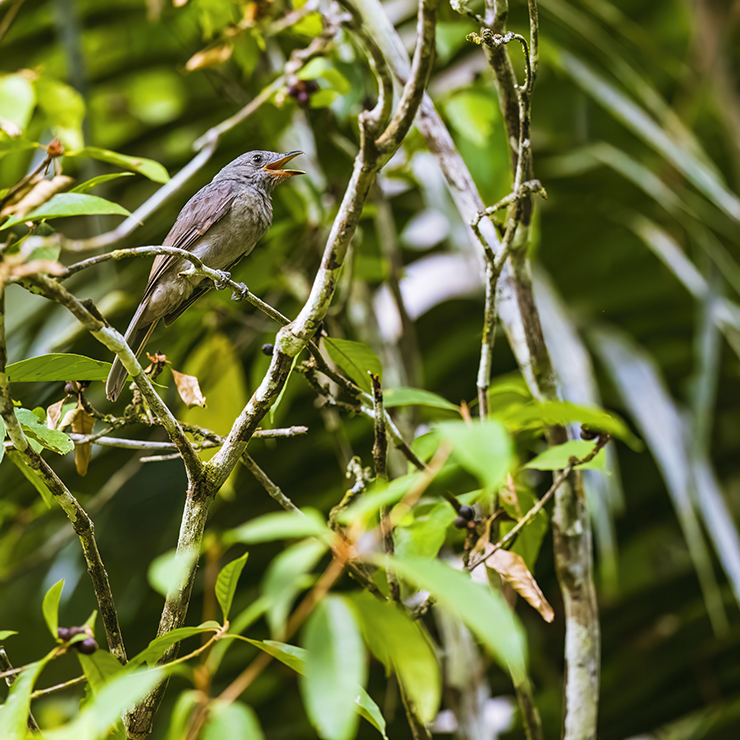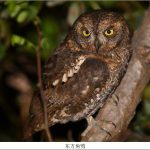
On a high after waking up in Guyana’s wild interior for the first time – with a spectacular morning of birding already under our belts – we resumed our southerly journey with full bellies. As difficult as it was to leave Iwokrama behind, we knew that we’d be back eventually.

The road through the interior was as it was the day before; an endless, undulating swath of red dirt bordered by dense forest on either side.

While we stopped to enjoy the hordes of sulphur butterflies feeding on the mineral rich soil, a flock of White-collared Swifts wheeled overhead.
Guyana had been suffering from an extensive period of drought when we visited, this lack of water ultimately was the primary reason which prevented us from searching for the Harpy Eagle. The known location that was on our itinerary was only accessible via a two-hour boat ride, and the water levels were dangerously low. Belligerently embarking on that journey meant signing up for a heavily delayed arrival and departure at best, and getting stuck until the return of the rains at worst. Suffice to say that when the first few droplets began to strike our windshield, the thought of rapidly swelling rivers facilitating our (now cancelled) journey in a few days did cross my mind. Unfortunately, this shower was brief.

The birds must have been anxious for the rain, but this Greater Yellow-headed Vulture didn’t seem to be too impressed.
The Iwokrama Canopy Walkway at Atta Lodge was our next destination, and it wasn’t long before we arrived. The lodge grounds were alive with birds on their afternoon feeding routine, including several Purple-throated Fruitcrows, one of several cotingas I had been drooling over for weeks.

Purple-throated Fruitcrow

Black-necked Aracari (above) and Channel-billed Toucan (below) patrolled the branches.

Another cotinga that is arguably the most popular member of that family – for its voice more so than its looks – is the Screaming Piha. This often overlooked bird is never ignored, however, as its vocalization has set the scene for many a jungle scene thanks to the movie industry. When one of these surprisingly large birds flew in to join the banquet on a fruiting tree, I knew this was my only chance. Difficult to spot and typically perched high in the trees, having an eye-level view was nothing short of a treat.

Screaming Piha
As exciting as the lodge grounds were, we were urged onto the trail such that we would be able to arrive at the canopy walkway before it got too dark – as the thirsty land was seemingly screaming for the rains to expedite their arrival. Sure enough as we began walking away from the clearing into the ever-darkening forest, the awareness of an impending shower began to become more apparent. I contemplated scrapping the mission altogether and returning to where I wouldn’t have to have an obscene ISO setting (apologies for the photographer-speak, but it was DARK) – but we kept pushing forward. Massive trees with serpentine buttresses stood like giant feet, supporting the entire canopy ecosystem that by this time was swaying in the wind. As we crested a small hill on the trail a bright red spot on a tree caught my eye. No question about it being a woodpecker – a most beautiful one at that!

This Red-necked Woodpecker gave us a good look before gliding to a slightly further tree.
Apart from the birds, I was smitten by the trees themselves. I’m a sucker for a big tree and this forest was filled with them. No longer than a minute after we parted ways with the Red-headed Woodpecker, we heard another light tapping overhead. A careful examination revealed yet another woodpecker – this time a Ringed Woodpecker excavating a hole about fifty metres up.

Ringed Woodpecker
As entertaining as woodpeckers can be, the winds were whipping the tops of the trees and it surely wasn’t long again to the arrival of the rain. Thus, we hustled a bit and began climbing to where the famous Iwokrama Canopy Walkway was rigged to the hillside. A bit breathless by the time we got there, the immediate task at hand was navigating the rope bridges that led to the viewing platforms. While there is video evidence of this learning curve, I will spare myself the embarrassment and simply assure you that I was nearing expert level at the end of the second bridge crossing.
The viewing platform presented us with a spectacular vista of an unbroken green carpet for as far as the eye could see. Over rolling hills into the distance, there was only verdant jungle. A White-throated Toucan provided some avian entertainment, albeit from a thousand miles away. A brief view of a hummingbird with purple undersides was likely a Fork-tailed Woodnymph, but it darted off the moment I touched my binoculars. At least I got eyes on that one – a few moments later everyone except me caught a half second view of a King Vulture as it banked behind a distant hillside.

Try to find the White-throated Toucan! Hint – it’s calling from a typical toucan perch.
Ultimately we decided that it was slow enough in the canopy to depart. Golden-headed Manakins were around but activity was gradually grinding to a halt. We made a non-stop descent back to the lodge, and not a moment too soon – the first drops of the downpour caught us as we returned to the grounds, nearly stumbling over a family of Black Currasow as we burst from the forest. I had dreams of photographing this species, as I knew there were a few that notoriously frequented the grounds at Atta Lodge. However, the torrential rain forced these large cracids back into the now almost completely dark forest just as it pushed us into shelter. Next time.











Great stuff. Makes birding in Suffolk/Norfolk pretty tame in comparison. I love the red-naped woodpecker…
Wonderful photos and great stories with descriptions